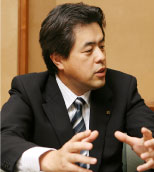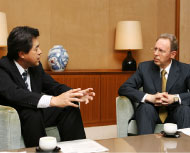Home > Sustainability > Feature in FY2008 > Kyocera Mita's environmental management centered on long-life-design printers and MFPs
Feature in FY2008:
Kyocera Mita's environmental management centered on long-life-design printers and MFPs

This interview, facilitated by Ms. Chiaki Kawahara (researcher at the Institute for Environmental Management Accounting), had Keiji Itsukushima (Managing Executive Officer/Senior General Manager, Corporate R&D Division 1, Kyocera Mita Corporation) as host and Dr. Karl-Heinz Feuerherd (professor, Department of Environmental & Cultural Studies, Faculty of Humanities, Kobe Yamate University) as guest discuss the background to the birth of ECOSYS products, the ECOSYS concept, the characteristics and market evaluation of ECOSYS, as well as Kyocera Mita's approach to environmental management as a global company and its future direction in environmental management.

Guest:
Dr. Karl-Heinz Feuerherd
Professor, Department of Environmental & Cultural Studies, Faculty of Humanities, Kobe Yamate University

Host:
Keiji Itsukushima
Managing Executive Officer / Senior General Manager, Corporate R&D Division 1, Kyocera Mita Corporation
[Facilitator] Ms. Chiaki Kawahara
- ECOSYS products deliver superior economic and social benefits, based on Kyocera's proprietary technology.
- Positioning environmental protection as one of the pillars of our business strategy, we are earnestly pursuing environmental activities.
ECOSYS products deliver superior economic and social benefits, based on Kyocera's proprietary technology.
Under what circumstances was ECOSYS developed?

Itsukushima:Although Kyocera achieved high profit margins since the launch of a printer with a drum cartridge in June 1986, we felt that we should offer products with a unique value distinct from our competitors.
Meanwhile, Kyocera had developed a unique amorphous silicon drum technology in another area outside the laser printer business, and incorporated the amorphous silicon drums into large copying machines. We then came up with the idea of developing a printer equipped with an amorphous silicon drum instead of an OPC (Organic Photo Conductor) drum. As a result of numerous trials and errors, we came to the conclusion that "long-life" was the primary benefit we should offer to our customers. ECOSYS printers, stemming from this idea, have achieved two key benefits; customer-oriented economic merits and environmental performance.
Feuerherd:I see. You have achieved economic and environmental benefits through technological development. Could you elaborate a bit more on these two benefits?
Itsukushima:Around 1983 when laser printers were first introduced to the market, such issues as cost-per-print and waste associated with drum cartridge replacement were not yet receiving much attention. At that time in Japan, the cost-per-print of a printer was about 5 yen. Kyocera considered that too expensive and tried to reduce the cost incurred by the user and provide significant cost benefits by extending the service life of consumable parts.
Feuerherd:You considered the cost of a printer in terms of the total cost of ownership, which included the initial purchase price and the operating cost, and tried to reduce this total cost. Now, could you explain the other benefit, "environmental performance"?
Itsukushima:In 1990, when the first trial model of a new laser printer was completed, we received some advice from Chairman Emeritus Inamori. His advice led to the development of the ECOSYS concept, which focuses on eco-friendliness as its biggest selling point. When we released ECOSYS printers into the German market in 1992, we set the price of the machine relatively high, demonstrating our intention to request the users to bear some of the costs of protecting the environment.
Feuerherd:At that time, was the environmentally consciousness of ECOSYS well understood by the German people?

Itsukushima:I think the environmentally consciousness of ECOSYS printers was understood relatively quickly. ECOSYS' low replacement frequency-in other words, the ECOSYS drum and toner container needed only to be replaced after 300,000 pages and 20,000 pages, respectively-attracted much attention from an environmental protection perspective. In Europe, many public agencies and large companies introduced ECOSYS printers on a lump-sum basis. Moreover, ECOSYS printers were widely reported in the mass media.
Feuerherd:Since in Germany strict environmental regulations came to be imposed on companies in the 1990s, ECOSYS printers attracted much public attention.Still, I imagine you encountered a number of difficulties in the course of your attempt to extend the service life of consumable parts, giving consideration to all stages of the product's life cycle.
Itsukushima:Yes. The service life of most peripheral parts used to be 10,000 to 50,000 pages, but we set the target service life for many peripheral parts at 300,000 pages, as for the amorphous silicon drum, and that was an extremely high hurdle for our engineers. We also developed a new packaging material, made from molded pulp, which is a recycled material.
Feuerherd:I can imagine how high the hurdle was, given the situation of the market at that time. Many of the parts comprising a laser printer are consumable items, aren't they? I imagine it was very difficult to extend the service life of all those parts.
Itsukushima:Yes. To extend the service life of all those parts, it was necessary for all engineers to adopt a challenging spirit.
Feuerherd:I understand that your strong desire and motivation to create a unique, innovative product not offered by other manufacturers were the driving force behind this. Did any other companies adopt your business model?

Itsukushima:So far, no companies have caught up with us. There are significant technical entry barriers, including the development of an amorphous silicon drum, as well as peripheral parts.
Feuerherd:You have developed innovative products that incorporate your proprietary technology, and have marketed such products at prices that cover the costs associated with environmental performance. Your products also provide significant benefits to customers in terms of operating costs. I think these are the major characteristics of your approach.
Itsukushima:We feel that environmental performance alone does not have sufficient appeal for customers. We think it is important to provide products that offer compelling performance and economic advantages, as well as low environmental load.
Home > Sustainability > Feature in FY2008 > Kyocera Mita's environmental management centered on long-life-design printers and MFPs
